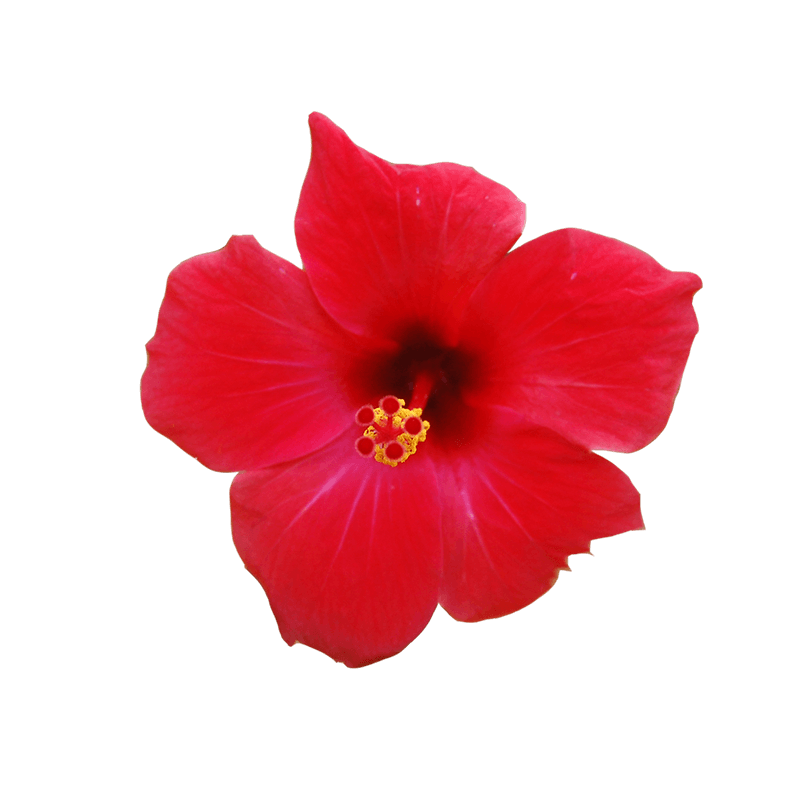
Hibiscus
Latin name
Origin
Used part
Active components
Organic acids (citric acid, malic and tartaric acid): have an acidic flavour and are often natural preservatives.
Anthocyanidins: responsible for the dark red colour, anti-inflammatory effect and are also a powerful antioxidant. They have a cholesterol-lowering and an antihypertensive effect, acting as angiotensin-converting enzyme (ACE) inhibitors.
Vitamin C and carotenoids: antioxidants.
Usage
Bibliographical references
- Pharmacological characterization of the diuretic effect of Hibiscus sabdariffa Linn (Malvaceae) extract.
Alarcón-Alonso J, Zamilpa A, Aguilar FA, Herrera-Ruiz M, Tortoriello J, Jimenez-Ferrer E.
J Ethnopharmacol. 2012 Feb 15;139(3):751-6.
Pubmed: http://www.ncbi.nlm.nih.gov/pubmed/22178178 - Diuretic effect of compounds from Hibiscus sabdariffa by modulation of the aldosterone activity.
Jiménez-Ferrer E, Alarcón-Alonso J, Aguilar-Rojas A, Zamilpa A, Jiménez-Ferrer C I, Tortoriello J, Herrera-Ruiz M.
Planta Med. 2012 Dec;78(18):1893-8.
Pubmed: http://www.ncbi.nlm.nih.gov/pubmed/23150077 - Verification of the folkloric diuretic claim of Hibiscus sabdariffa L. petal extract
CN Aguwa, OO Ndu, CC Nwanma, PO Udeogaranya, NO Akwara
Nig. J. Pharm. Res. 3(1) 2004: 1-8
African Journals Online: http://www.ajol.info/index.php/njpr/article/view/35377 - Herbal medicines as diuretics: a review of the scientific evidence.
Wright CI, Van-Buren L, Kroner CI, Koning MM.
J Ethnopharmacol. 2007 Oct 8;114(1):1-31.
Pubmed: http://www.ncbi.nlm.nih.gov/pubmed/17804183 - The effectiveness of Hibiscus sabdariffa in the treatment of hypertension: a systematic review.
Wahabi HA, Alansary LA, Al-Sabban AH, Glasziuo P.
Phytomedicine. 2010 Feb;17(2):83-6
Pubmed: http://www.ncbi.nlm.nih.gov/pubmed/19801187 - Hibiscus sabdariffa L. in the treatment of hypertension and hyperlipidemia: a comprehensive review of animal and human studies.
Hopkins AL, Lamm MG, Funk JL, Ritenbaugh C.
Fitoterapia. 2013 Mar;85:84-94.
Pubmed: http://www.ncbi.nlm.nih.gov/pubmed/23333908 - Clinical effects produced by a standardized herbal medicinal product of Hibiscus sabdariffa on patients with hypertension. A randomized, double-blind, lisinopril-controlled clinical trial.
Herrera-Arellano A, Miranda-Sánchez J, Avila-Castro P, Herrera-Alvarez S, Jiménez-Ferrer JE, Zamilpa A, Román-Ramos R, Ponce-Monter H, Tortoriello J.
Planta Med. 2007 Jan;73(1):6-12.
Pubmed: http://www.ncbi.nlm.nih.gov/pubmed/17315307 - An evaluation of the hypolipidemic effect of an extract of Hibiscus Sabdariffa leaves in hyperlipidemic Indians: a double blind, placebo controlled trial.
Kuriyan R, Kumar DR, R R, Kurpad AV.
BMC Complement Altern Med. 2010 Jun 17;10:27
Bio Med Central: http://www.biomedcentral.com/content/pdf/1472-6882-10-27.pdf - Modification of the liver fatty acids by Hibiscus sabdariffa Linnaeus (Malvaceae) infusion, its possible effect on vascular reactivity in a metabolic syndrome model.
Pérez-Torres I, Zúñiga Muñoz A, Beltrán-Rodríguez U, Díaz-Díaz E, Martínez-Memije R, Guarner Lans V.
Clin Exp Hypertens. 2013 Jun 4.
Pubmed: http://www.ncbi.nlm.nih.gov/pubmed/23734849 - Mechanisms of the blood pressure lowering effect of the calyx extract of Hibiscus sabdariffa in rats.
Adegunloye BJ, Omoniyi JO, Owolabi OA, Ajagbonna OP, Sofola OA, Coker HA.
Afr J Med Med Sci. 1996 Sep;25(3):235-8.
Pubmed: http://www.ncbi.nlm.nih.gov/pubmed/10457797 - Inhibition of angiotensin convertin enzyme (ACE) activity by the anthocyanins delphinidin- and cyanidin-3-O-sambubiosides from Hibiscus sabdariffa.
Ojeda D, Jiménez-Ferrer E, Zamilpa A, Herrera-Arellano A, Tortoriello J, Alvarez L.
J Ethnopharmacol. 2010 Jan 8;127(1):7-10.
Pubmed: http://www.ncbi.nlm.nih.gov/pubmed/19808084 - Antioxidant and drug detoxification potentials of Hibiscus sabdariffa anthocyanin extract.
Ajiboye TO, Salawu NA, Yakubu MT, Oladiji AT, Akanji MA, Okogun JI.
Drug Chem Toxicol. 2011 Apr;34(2):109-15.
Pubmed: http://www.ncbi.nlm.nih.gov/pubmed/21314460 - Chemopreventive properties and molecular mechanisms of the bioactive compounds in Hibiscus sabdariffa Linne.
Lin HH, Chen JH, Wang CJ.
Curr Med Chem. 2011;18(8):1245-54.
Pubmed: http://www.ncbi.nlm.nih.gov/pubmed/21291361 - Hibiscus sabdariffa ethanolic extract protects against dyslipidemia and oxidative stress induced by chronic cholesterol administration in rabbits.
Ekor M, Adesanoye OA, Udo IE, Adegoke OA, Raji J, Farombi EO.
Afr J Med Med Sci. 2010 Dec;39 Suppl:161-70.
Pubmed: http://www.ncbi.nlm.nih.gov/pubmed/22416659 - In vitro vasorelaxation mechanisms of bioactive compounds extracted from Hibiscus sabdariffa on rat thoracic aorta.
Sarr M, Ngom S, Kane MO, Wele A, Diop D, Sarr B, Gueye L, Andriantsitohaina R, Diallo AS.
Nutr Metab (Lond). 2009 Nov 2;6:45.
Pubmed: http://www.ncbi.nlm.nih.gov/pubmed/19883513 - The aqueous extract of Hibiscus sabdariffa calices modulates the production of monocyte chemoattractant protein-1 in humans.
Beltrán-Debón R, Alonso-Villaverde C, Aragonès G, Rodríguez-Medina I, Rull A, Micol V, Segura-Carretero A, Fernández-Gutiérrez A, Camps J, Joven J.
Phytomedicine. 2010 Mar;17(3-4):186-91.
Pubmed: http://www.ncbi.nlm.nih.gov/pubmed/19765963 - Polyphenols extracted from Hibiscus sabdariffa L. inhibited lipopolysaccharide-induced inflammation by improving antioxidative conditions and regulating cyclooxygenase-2 expression.
Kao ES, Hsu JD, Wang CJ, Yang SH, Cheng SY, Lee HJ.
Biosci Biotechnol Biochem. 2009 Feb;73(2):385-90.
Pubmed: http://www.ncbi.nlm.nih.gov/pubmed/19202285 - Chronic administration of aqueous extract of Hibiscus sabdariffa attenuates hypertension and reverses cardiac hypertrophy in 2K-1C hypertensive rats.
Odigie IP, Ettarh RR, Adigun SA.
J Ethnopharmacol. 2003 Jun;86(2-3):181-5.
Pubmed: http://www.ncbi.nlm.nih.gov/pubmed/12738084 - Inhibitory effects of Hibiscus sabdariffa L extract on low-density lipoprotein oxidation and anti-hyperlipidemia in fructose-fed and cholesterol-fed rats
Chang-Che Chen, Fen-Pi Chou, Yung-Chyan Ho, Wea-Lung Lin, Chin-Pin Wang, Erl-Shyh Kao, An-Chung Huang, Chau-Jong Wang
Journal of the Science of Food and Agriculture Volume 84, Issue 15, pages 1989–1996, 2004
Wiley Online Library: http://onlinelibrary.wiley.com/doi/10.1002/jsfa.1872/abstract - Hibiscus sabdariffa extract reduces serum cholesterol in men and women.
Tzu-Li Lina, Hui-Hsuan Linb, Chang-Che Chenb, Ming-Cheng Linc, Ming-Chih Choud, Chau-Jong Wangb
Nutrition Research 27 (2007) 140 – 145
Biodiversity: http://www.aseanbiodiversity.info/abstract/51007368.pdf
The health claims that feature on our website in relation to the plants contained in our products are compliant with the list of health claims awaiting final assessment by the Community authorities (cf. website of the European Commission: http://ec.europa.eu/nuhclaims/). However, they may be subject to modification following their assessment by the national competent authorities.
The health claims relating to other nutrients or substances contained in our products that feature on our site are compliant with Regulation No. 432/2012 of the Commission of 16 May 2012 which establishes a list of authorised health claims authorised in relation to food products, other than those in reference to the reduction of the risk of disease as well as community-based development and child health (cf. website of the European Commission: http://ec.europa.eu/nuhclaims/).

 Belgique
Belgique  België
België  France
France  Italia
Italia  Portugal
Portugal  España
España  United Kingdom
United Kingdom  Κύπρος
Κύπρος 